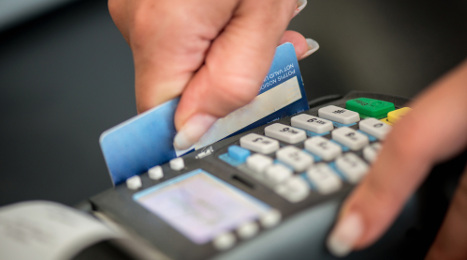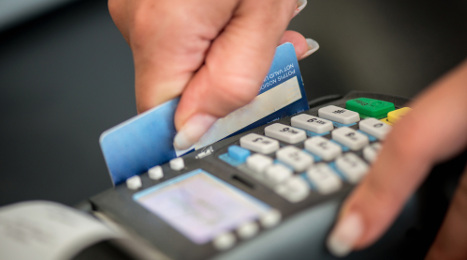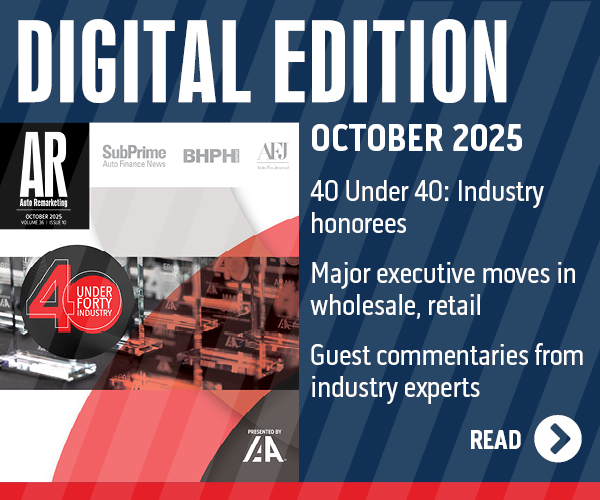Autoscribe Corp. brought on Myles Locke as its new chief financial officer this week.
Locke spent the past 17 years in various leadership roles in payments, finance and card processing, including vice president of finance and vice president of corporate development at Global Payments.
In his role at Autoscribe, Locke will provide strategic financial direction for the company to meet the needs of customers and future prospects and will be a part of the executive team, reporting to chief executive officer Robert Pollin.
“We are very pleased to have Myles Locke joining our team,” Pollin said. “Myles is an experienced and talented CFO with substantial background in payments and technology, servicing multiple markets including health care, auto finance, consumer finance, banking and credit unions and collections and receivables.
"His track record demonstrates an ability to create value and growth for organizations, and we look forward to Myles leveraging his expertise to enhance our organization,” Pollin continued.
In reacting to his new post, Locke added, “I am very excited to be joining Autoscribe Corporation and its leadership team.
“Autoscribe is a company with tremendous capabilities, talented team members, and market leadership positions in a growing industry,” Locke went on to say. “There is great opportunity to continue building on the company’s success as the leader in payments and financial technology.”
While finance company executives know it’s important to originate vehicle installment contracts, they also understand it’s vital to keep those accounts current and monthly payments flowing into the company’s account.
In an analysis sent this week to SubPrime Auto Finance News, BillingTree head of corporate marketing Dave Yohe previewed three trends that will impact payments in 2016.
1. EMV? The next step is EMVco compliance and tightened CNP security
In 2015, EMV — which stands for Europay, MasterCard and Visa — was the “hot topic” as the industry looked to the liability shift on Oct. 1. Reports say the U.S. is migrating slowly to the new chip-and-PIN payment method with MasterCard reporting 46 percent of Americans had not received chip-and-PIN cards, and only 41 percent of merchants had installed terminals to accept them.
But as take-up of the new system increases, so will the importance of new compliance measures set up by EMVco — the consortium that manages EMV standards.
We predict a double edged sword for vendors in 2016. They will have to make sure they comply with EMVco standards for all payment methods — including contact, contactless, mobile and tokenization. At the same time security for card-not-present payments needs to be as tight as possible, as industry opinion predicts fraud moving towards these types of transactions due to the EMV liability shift.
2. Millennials disrupting traditional banking
In the 2015 Banking Industry Growth Strategy Survey, Bank Director found 60 percent of banking executives felt they didn't have the right products, services and delivery methods to address a “decidedly untraditional digital generation.”
In the payments space in 2016 as the number of millennials taking out loans, buying houses and signing up for auto finance increases, organizations that offer 'Generation Y' their preferred payment method will gain a competitive edge. This means offering them a path of least resistance at the payment stage — which means offering digital payment channels such as online portals, mobile and automatic interactive voice response.
3. Continued FinTech development
With the disruptive influences of a changing regulatory landscape and millennials' payment preferences, financial technology will continue its rapid development.
The U.S. is the global leader in Fintech investment according to Statista research, with $3.97 billion invested in 2014. We will see the emergence of modernized gateways to support the latest banking and compliance rules alongside an appetite for modern technology and devices.
Financial technology will be developed to support traditional and non-traditional channels in order to appeal to the widest possible customer range in 2016.
Veteran F&I managers might remember a time when stretching terms beyond 36 months to complete the financing for a used-vehicle installment contract seemed outlandish. Now getting deals bought and used models delivered with terms double that term length is more commonplace.
In its Q3 Used Vehicle Market Report, Edmunds.com provided further evidence to the degree longer terms are prevalent.
“Higher vehicle values have caused a dramatic shift in the way that consumers finance,” analysts said. “In order to keep monthly payments at manageable levels the trend toward loans over five years is now the norm.
“Comparatively, five years ago these loans only represented 40 percent of the business but in today’s market they are the majority at 65 percent,” they continued.
The report contain comparisons between payment and term metrics Edmunds pinpointed for this year to show the expansion from 2010. Here is the breakdown:
Average Monthly Payment by Term Length
Used Term
(months) |
2010 |
2015 |
2015 vs. 2010 |
| 1-12 |
$422 |
$374 |
-11.3% |
| 13-18 |
$275 |
$241 |
-12.4% |
| 19-24 |
$440 |
$380 |
-13.6% |
| 25-30 |
$289 |
$278 |
-3.7% |
| 31-36 |
$339 |
$327 |
-3.5% |
| 37-42 |
$321 |
$299 |
-7.0% |
| 43-48 |
$316 |
$308 |
-2.5% |
| 49-54 |
$327 |
$319 |
-2.6% |
| 55-60 |
$347 |
$345 |
-0.7% |
| 61-66 |
$369 |
$351 |
-4.9% |
| 67-72 |
$387 |
$397 |
2.4% |
| 73-84 |
$398 |
$409 |
2.7% |
| Average |
$360 |
$375 |
4.1% |
“Lower interest rates and increased terms has made monthly payments at nearly all term lengths lower than 2010 levels,” analysts said. “However, we are seeing an increase in monthly payment for those loans with the longest terms.
“The higher concentration of longer terms loans has brought up the monthly payment average to $375 from $360 in 2010,” they added.
Autoscribe Corp., provider of PaymentVision and Lyons Commercial Data, has been named a silver winner in the Best in Biz Awards, an independent business awards program judged by members of the press and industry analysts.
Autoscribe — also a recent winner in the Stevie Awards, Inc. 5000 List, Jacksonville Business Journal BizTech Awards and more — received a silver honor in the Finance Executive of the Year and a silver honor in the Legal Executive of the Year categories. The honors went to chief financial officer Raj Gupta and Laurie Nelson, chief compliance officer and general counsel.
With more than two decades of innovation in the financial technology industry, Autoscribe offers a full suite of tools through PaymentVision and Lyons Commercial Data to help their customers grow their business, simplify payment processing, mitigate risk, and ensure compliance.
The fifth annual program in North America boasted the highest number of submissions to date. More than 600 entries were received this year, from a wide array of public and private companies of all sizes and from a variety of industries and geographic regions in the U.S. and Canada.
“We are thrilled to be recognized in this year’s Best in Biz Awards for finance executive of the year and legal executive of the year,” Autoscribe vice president Eugene O’Rourke said.
“We remain committed to providing best-in-class service along with the most secure, compliant and state-of-the-art tools in the industry. Recognition in the Best in Biz Awards serves to confirm our commitment to excellence as well as the bright future for Autoscribe,” O’Rourke continued.
Best in Biz Awards 2015 honors were presented in 60 categories, including Company of the Year, Fastest-Growing Company of the Year, Most Innovative Company of the Year, Best Place to Work, Technology Department of the Year, Executive of the Year, Most Innovative Product of the Year, Best New Product of the Year, Marketing Campaign of the Year and Website of the Year.
Winners of Best in Biz Awards 2015 were determined based on scoring from an independent panel of 46 judges from highly recognized newspapers, business, consumer and technology publications, radio outlets and analyst firms
“In the more than 15 years that I have been covering enterprise and consumer technology, it’s been fascinating to watch ‘old school’ tools and technologies evolve for the cloud era,” said Mathew Schwartz of InfoRiskToday, who returned to the Best in Biz Awards judging panel for the second time.
“What struck me most about this year’s entries in the Best in Biz Awards were the businesses that — brand names or not, long-established players or even more recently birthed organizations — continue to grapple with how to best reinvent themselves, and by doing so best tap the latest technology possibilities and capabilities for better attracting, retaining and serving their customers,” Schwartz added.
For a full list of gold, silver and bronze winners in Best in Biz Awards 2015, visit http://www.bestinbizawards.com/2015-winners.
As captive activity also registered gains, Experian Automotive highlighted on Wednesday that what it classifies as finance companies — institutions that don’t hold customer deposits but get most of their business from consumers with subprime and deep-subprime credit — gained a healthy amount of market share year-over-year during the third quarter.
According to the Q3 2015 State of the Automotive Finance Market report, finance company market share reached 13.34 percent in Q3, up 6.4 percent from the previous year.
Meanwhile, Experian indicated one of the biggest shifts in the automotive lending industry during Q3 was the resurgence of captive lenders — the lending companies owned by vehicle manufacturers.
In the third quarter, captive lenders financed 51.6 percent of new-vehicle loans, up from 36.8 percent in Q3 2011. This gain represents the largest market share of new-vehicle financing for captives since the recession.
Market share findings for other lending types show commercial banks still holding the largest share for new and used vehicle loans combined, at 34.7 percent.
“Captive lending has made a comeback since suffering a steep drop-off caused by declining new sales and lender-type shifts during the recession,” said Melinda Zabritski, Experian’s senior director of automotive finance.
“This is good news for manufacturers, as their captive finance companies often provide an additional source of revenue as well as a strong pipeline to credit for their dealer networks,” Zabritski continued
Experian mentioned five other interesting findings from its Q3 data, including:
• Consumers continue to rely on financing; the percentage of new vehicles financed reached an all-time high of 86.6 percent.
• The average credit score for a new vehicle loan fell to 710, the lowest since Q3 2007.
• During Q3, the average monthly payment for a new vehicle was $482, up $12 from the previous year.
• The average monthly payment for a used vehicle reached $361, an increase of $3 from a year ago.
• The average interest rate for a new vehicle hit 4.63 percent, while the average interest rate for a used vehicle reached 8.76 percent.
More leasing as contract terms lengthen
Experian has never seen this many new models roll over the curb connected to a lease.
Zabritski indicated leasing accounted for nearly 27 percent of all new-vehicle transactions in Q3, up from 24.7 percent the previous year. This level marks the highest percentage of vehicles leased since Experian began tracking the data publicly in 2006.
Findings from the report also showed that the average monthly lease payment was $398 during the quarter, up $1 from a year ago.
“As the price for a new or used vehicle continues to rise, leasing has become a more viable financing option for consumers looking to maintain an affordable monthly payment,” Zabritski said.
“While consumers can save an average of $84 per month by leasing rather than taking out a loan on a new vehicle, they should make sure leasing fits their lifestyle,” she continued. “Oftentimes there are mileage caps and other considerations that consumers should familiarize themselves with before entering into a leasing agreement.”
Rising vehicle prices also have given way to record loan amounts for new and used vehicles.
During the third quarter, the average amount financed for a new vehicle was $28,936, up $1,137 from the previous year.
The average amount financed for a used vehicle was $18,866, up $290 over the same time period.
Furthermore, Experian pointed out the gap between new and used loan amounts also has grown. On average, consumers finance $10,070 less on a used vehicle than on a new one.
Extending loan terms is another method consumers turned to in order to keep monthly payments low. During Q3, Experian determined the percentage of consumers who took out new and used vehicle loans with terms between 61 and 72 months reached all-time highs.
For new vehicles, approximately 44 percent took out 61- to 72-month loans, and more than 41 percent financed a used vehicle for the same duration.
Analysts noticed the percentage of consumers extending their loans even longer also has increased.
Loans for new vehicles extending 73 to 84 months increased 17.1 percent over the previous year, reaching a Q3 record high of 27.5 percent.
Used-vehicle loans extending in the 73- to 84-month term, however, reached an all-time high of 16.2 percent (a 12-percent increase over the previous year).
DriveItNow, a provider of online pre-qualified monthly payment marketing technology, finalized a partnership this week with GoMoto, a dealership engagement solutions provider.
Executives explained DriveItNow will be integrated with GoMoto’s mobile kiosk technology to improve the shopper experience and boost sales for dealers.
GoMoto’s patent pending customer experience platform uses tablets and touch-screen computer displays to urge customers inside the dealership to explore products, services and specials, while capitalizing on sales conversion points and improving the overall performance of dealership BDCs, sales, F&I and service Departments.
DriveItNow’s patent pending pre-qualification payment quoting technology can display real monthly payments using dealers’ finance company programs and consumers’ actual credit bureau information, without the need for Social Security numbers/birthdates and adversely affecting consumer credit.
In-store shoppers can see personalized monthly finance and lease payment offers powered by DriveItNow on the GoMoto platform, which can enable them to take immediate action, translating to real-time results for dealers.
According to the most recent J.D. Power 2015 US Sales Satisfaction Index Survey, the use of technology tablets and computer displays by dealers during the sales process can substantially improve efficiency, resulting in increased customer satisfaction among new vehicle buyers. Consumer satisfaction soars when finance options are presented on a computer or tablet screen, compared to other methods, including printed materials, verbal quotes, and handwritten figures.
“We are very pleased to add GoMoto as a valued partner to deliver efficiency to the dealership sales process. Given an increasingly tech-savvy consumer, dealers that seamlessly connect consumers’ online experiences to the in-store environment will deliver superior customer satisfaction, DriveItNow president Tarry Shebesta said.
GoMoto chief executive officer Todd Marcelle added, “We are excited to announce an integrated customer experience with DriveItNow as they offer a proven engagement tool that generates more sales and profits for our dealers.
“Our integration allows dealers to increase transparency, reduce the sales transaction time, and improve the in-store experience,” Marcelle went on to say.
MakeMyDeal, a Cox Automotive company that is geared to enable dealers and shoppers to negotiate a vehicle deal online, recently rolled out a new solution it’s calling F&I Connect.
The company explained this product is designed to bring the finance and insurance process “into the digital age.” Powered by F&I Express, F&I Connect can let dealers promote their F&I products and prices in a controlled online environment while giving consumers the opportunity to learn about financing and insurance program options before finalizing their deal.
“Our research shows that there is an opportunity within the current F&I process to better educate consumers about the value of F&I products, reduce the time they spend in the F&I office and improve their satisfaction with the overall buying process,” said Mike Burgiss, vice president and general manager of MakeMyDeal.
“By bringing F&I information and pricing online, we are able to give consumers a better understanding of their options, which can ultimately have positive effects for the dealership in terms of satisfaction and sales,” Burgiss continued.
A 2015 study commissioned by MakeMyDeal shows that while 84 percent of consumers believe that F&I products may have real value, 54 percent say that they prefer to simply complete their purchase and leave the dealership as quickly as possible.
The study indicates that the majority of vehicle purchasers feel that they are familiar with F&I products. However, when asked to define F&I products and services, the study reveals a significant gap in consumer understanding.
Additionally, 83 percent are interested in learning about F&I products before entering the dealership, and 63 percent would be more likely to buy F&I products if they could learn about them on their own time, before finalizing their vehicle purchase.
MakeMyDeal F&I Connect, powered by F&I Express, is designed to do just that — provide dealers with the opportunity to present their F&I products online to educate consumers about their options and ensure that they are a part of the total purchase consideration set.
“F&I Express has the largest aftermarket provider network in the industry with more continually joining,”, President and CEO of F&I Express president and chief executive officer Brian Reed said.
“Our digital platform provides dealers with instantaneous and accurate rates for aftermarket products,” Reed continued. “Powering F&I Connect allows us to bring the customer information earlier in the car buying process, resulting in more sales. It’s a win for everyone.”
The MakeMyDeal F&I product was launched in beta with select dealers in June. Dealers who are interested in learning more should contact MakeMyDeal at (800) 309-2040.
Outstanding car loans hit a high point in the third quarter and have climbed more than 53 percent in the last five years, which appear to be good signs for the industry. As does the increase in car sales that has come with this rebound in auto finance.
However, Experian’s Melinda Zabritksi says, whether these rosy times continue hinges largely on consumers continuing to make their payments.
And for the most part, they have done so.
According to the State of the Automotive Finance Market report from Experian Automotive, 30-day delinquencies fell from 2.7 percent in the third quarter of 2014 to 2.5 percent in Q3 2015.
Likewise, 60-day delinquencies showed a similar decline, moving from 0.74 percent to 0.73 percent.
Overall, outstanding auto loan balances were at $968 billion in the third quarter, which Experian said was its highest level. A year ago, total open balances were at $870 billion. The year before, $784 billion.
Perhaps most important, the Q3 2015 figure is more than 53 percent higher than the post-recession trough.
“Continued growth in the automotive finance market is a clear sign of improved consumer confidence over the past few years,” Zabritski, Experian’s senior director of automotive finance, said in the company's news release accompanying the study results.
“Since bottoming out in the recession, automotive sales have rebounded steadily, which is a good sign for consumers, automotive manufacturers, lending organizations and the overall economy. What’s critical to this success is that consumers stay on top of their payments,” she added. “If they can continue to manage their financial obligations and make timely payments, the automotive industry can continue to flourish and grow for quite some time.”
Breaking down the credit tiers of open loans
- 20.82 percent of open loans were super prime.
- 40.36 percent were prime.
- 18.42 percent were nonprime.
- 16.61 percent were subprime.
- 3.79 percent were deep subprime.
Experian said in its news release for the study that “the distribution of open loans by risk segment remains relatively unchanged, demonstrating that the surge in outstanding automotive financing is driven by consumers across the board, not a specific segment of the market.”
The super prime category had the biggest year-over-year jump in open loan volume (up 8.34 percent), but subprime (up 7.8 percent) and nonprime (up 7.7 percent) weren’t far behind.
BillingTree highlighted four main observations from its Consumer Finance Business Strategy and Technology Survey 2015; a project geared to try to understand the usage of payment technology solutions and the priorities of decision-making consumer lending professionals as well as to establish a benchmark to examine year-over-year trends as the industry navigates a shifting business and regulatory environment.
BillingTree commissioned the study, which was conducted by SourceMedia Research in August drawing on American Banker’s audience of financial services decision makers. According to the subsequent report, titled “Consumer Finance Business Strategy and Technology Survey 2015,” officials noted key observations and findings included:
1. Paper checks represent 41 percent of all U.S. loan payments, and when combined with cash payments (11 percent), more than half of all loans are paid non-electronically by consumers.
2. Fraud mitigation, data security and compliance were cited as the factors most critical to business growth by lenders.
3. E-mail is the primary communication method deployed by lenders for post loan communications followed closely by paper mail.
4. In addition, the report breaks out findings by financial institution size and offers more granular information including technology utilization, payment acceptance, communications and more.
In addition, BillingTree also re-established its Payment and Technology Spotlight webinar series, focused on informing and sharing best practice advice with financial industry professionals. The next webinar will be conducted Nov. 4 at 2 p.m. ET and will review the survey results in greater detail.
Registration for the complimentary webinar, which includes a copy of the survey results, is now open here.
“Last year's spotlight series saw record attendance, with hundreds of industry professionals attending our sessions. This should continue to rise this year, as more decision makers explore the bottom line and compliance benefits of incorporating payment technology into their business strategy,” BillingTree head of marketing Dave Yohe said.
“A growing awareness is reflected in the responses from our recent survey of lending institutions, where compliance and security ranked as top-of-mind concerns for industry professionals, with the use of payment technology continuing to close the gap on more traditional payment channels,” Yohe continued.
“This first interactive webinar in the spotlight series gives us a chance to take a deeper dive into the results and benchmark these against the concerns of attendees,” he went on to say.
BillingTree hired a director of new business development on Tuesday to focus on extending access to the company’s payment services and solutions to broader markets and industries, including auto finance.
Taking on this post is Greg Mallin, whose position was created to facilitate growth and demand as a staff addition reporting to vice president of sales and business development Chad Probst.
Mallin joined BillingTree from MasterCard Worldwide where he held the leadership position of vice president, strategic accounts for U.S. markets. He has also held roles at GE as manager of client development and Transamerica where he was director of retail finance.
“It’s an exciting time and terrific opportunity to be joining BillingTree as we develop and launch the Payrazr platform,” Mallin said. “I look forward to introducing Payrazr solutions and BillingTree’s services to new industries seeking omni-channel alternatives to capturing payments.”
Probst added that “We’ve already seen tremendous interest and adoption of our Payrazr solutions by current partners within ARM and auto finance,”
“Adding Greg to the team ensures the range of payment methods provided by Payrazr will be available to a broader audience, enabling companies to meet more individual consumer needs, improve customer satisfaction and drive revenue,” Probst went on to say.
Companies interested in adding BillingTree Payment Services and/or Payrazr Payment Solutions can contact Mallin at [email protected] or at (602) 443-5914.












